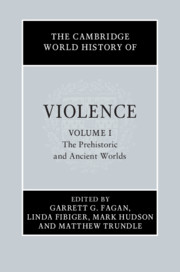Book contents
- The Cambridge World History of Violence
- The Cambridge History of Violence
- The Cambridge World History of Violence
- Copyright page
- Contents
- Figures
- Maps
- Contributors to Volume i
- General Introduction: Violence in World History
- Introduction to Volume I
- Part I The Origins of Conflict
- Part II Prehistoric and Ancient Warfare
- Part III Intimate and Collective Violence
- Part IV Religion, Ritual and Violence
- 21 Ritual Violence and Headhunting in Iron Age Europe
- 22 Ritual Killing and Human Sacrifice in the Ancient Near East
- 23 Violent Sacrifice in the Ancient Greek and Roman Worlds
- 24 Combat Sports in Ancient Greece and Rome
- 25 Religious Violence in Late Antiquity
- Part V Violence, Crime and the State
- Part VI Representations and Constructions of Violence
- Index
- References
21 - Ritual Violence and Headhunting in Iron Age Europe
from Part IV - Religion, Ritual and Violence
Published online by Cambridge University Press: 13 March 2020
- The Cambridge World History of Violence
- The Cambridge History of Violence
- The Cambridge World History of Violence
- Copyright page
- Contents
- Figures
- Maps
- Contributors to Volume i
- General Introduction: Violence in World History
- Introduction to Volume I
- Part I The Origins of Conflict
- Part II Prehistoric and Ancient Warfare
- Part III Intimate and Collective Violence
- Part IV Religion, Ritual and Violence
- 21 Ritual Violence and Headhunting in Iron Age Europe
- 22 Ritual Killing and Human Sacrifice in the Ancient Near East
- 23 Violent Sacrifice in the Ancient Greek and Roman Worlds
- 24 Combat Sports in Ancient Greece and Rome
- 25 Religious Violence in Late Antiquity
- Part V Violence, Crime and the State
- Part VI Representations and Constructions of Violence
- Index
- References
Summary
The ritualisation of violence in Iron Age Europe has long been seen through the distorting lens of classical literary sources. Signs of perimortem trauma and the complex processing of human remains have typically been seen as evidence for Druidic sacrifice or the ‘Celtic cult of the head’. This chapter presents a more anthropological perspective, drawing analogies with societies documented through the ethnographic literature. Evidence for ritualised killing in the Iron Age comes from bodies found preserved in peat bogs, who suffered extremely violent deaths. Similarly, complex killings are represented by skeletal evidence from archaeological sites ranging from small settlements to large religious complexes. Despite differences in scale, similar cosmological principles underlie these sorts of practices across the Continent. Particularly common is a concern with the removal, curation and display of the human head; rather than representing a singular ‘cult of the head’, however, headhunting was a complex and recurrent practice that altered its character and meaning through time. The ritualisation of warfare is also implicit in the design of major hill forts and oppida. Overall, the archaeological evidence suggests that ritualised violence was a core element of the religious and cosmological beliefs that underpinned social relations in Iron Age Europe.
Keywords
- Type
- Chapter
- Information
- The Cambridge World History of Violence , pp. 441 - 459Publisher: Cambridge University PressPrint publication year: 2020
References
Bibliographic Essay
- 2
- Cited by

